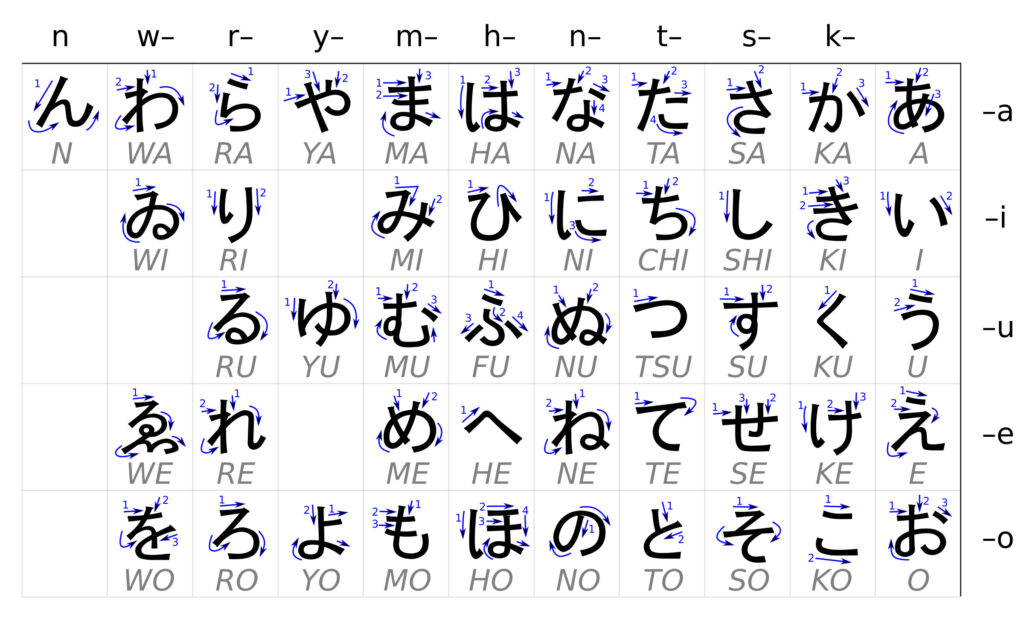Kanji and Kana
Japanese is unique in using three scripts: Kanji, Hiragana, and Katakana. Each has its own role and history. Together, the Kanji and Kana create a rich, complex writing system that reflects the beauty of the language.
Kana
The Kana are the Japanese syllabary alphabet. With the Kana, you can read and write the hole laguage, at least in theorie. The modern Japanese is using to kinds of this scriptures. Both contain the same sounds but have different characters to represent them.
Oirigin of the Kana
In the 9th century, a Japanese monk invented the kana, the first widely used script for the Japanese language. This new system evolved from Man’yogana, which borrowed classical Chinese characters based on their sound, not their meaning. The style of Hiragana was deliberately made round and calligraphic. Women of the Heian period popularized Hiragana, as society excluded them from the formal education that focused on Chinese characters. Hiragana allowed them to write letters, poetry, and diaries, making it essential to Japanese literature during this era.
Hiragana in modern Japanese
Today, people widely use Hiragana in beginner texts, for grammatical endings, for building words from Kanji, and for Furigana. Writers use Furigana by placing Hiragana over Kanji to explain its reading. In Japan, people write Furigana over complex or less commonly known Kanji to aid understanding.
Katakana in modern japanese
Katakana are used loanwords from foreign languages, mostly English and German. If you see a word written in katakana, you can be certan that this word is not a native japanese word. Often they try to imkitate the original spoken word but with a twist so japanesese speaker can pronounce it cleary.

Kanji
Kanji and Kana are serving different purposes in the Japanese language. Kanji are undoubtedly the most complex and challenging characters to learn. Originating from Chinese characters, Kanji play a crucial role in the Japanese writing system. However, they come with a distinctive twist that makes them unique to Japan. Their structure largely follows Chinese characters, but Japan actively adapted their usage and pronunciation to fit the Japanese language. Most Kanji have at least two readings, which adds to the complexity of mastering them. The context of the Kanji determines its readings, making it essential to understand how each one functions within a sentence. I would say, Kanji is the most fascinating japanese scripture. Most Kanji have more then one reading. Lets explore them.
Onyomi reading
The Onyomi reading is derived from the original Chinese pronunciation. This reading was borrowed when Kanji were first introduced to Japan over a thousand years ago. However, as both Chinese and Japanese evolved, the Onyomi reading often became distinct from its original Chinese counterpart. In modern Japanese, Onyomi is typically used when Kanji appear in compound words, where two or more Kanji are combined to form a new term. This reading gives Kanji their more formal or technical pronunciation.
Kunyomi reading
On the other hand, the Kunyomi reading is the native Japanese interpretation of a Kanji. It developed as a way to match Kanji to pre-existing Japanese words. Japanese speakers generally use Kunyomi when a Kanji appears alone or with hiragana attached, especially in words of Japanese origin. This reading feels more natural and often appears in everyday conversations. Understanding when to use Onyomi and Kunyomi is key to mastering Kanji, as their meanings and readings change depending on the words they form.
Romaji in modern Japanese
In modern Japanese, Romaji is becoming increasingly important alongside the Kanji and Kana. Romaji uses the Roman alphabet to write Japanese words and has grown in popularity, especially in the fields of marketing and everyday communication.
Everyday Usage of Romaji
Romaji also plays a key role in daily life, particularly in signage, public transportation, and technology. In cities, you’ll see Romaji on street signs, train station names, and menus, helping tourists and foreigners navigate Japan. It is also used in digital communications, where typing in Romaji can be more efficient, especially for those unfamiliar with the Japanese keyboard. This makes Romaji an essential tool for language learners and visitors alike.
The Role of Romaji in Marketing
Marketers frequently use Romaji to create brand names and slogans that non-Japanese speakers can easily understand. It gives businesses a global appeal while still maintaining a connection to the Japanese language. You’ll often see Romaji on packaging, product names, and advertisements, as companies seek to reach an international audience. For example, famous Japanese brands like “Sony” and “Uniqlo” use Romaji to ensure their names are recognizable worldwide.

